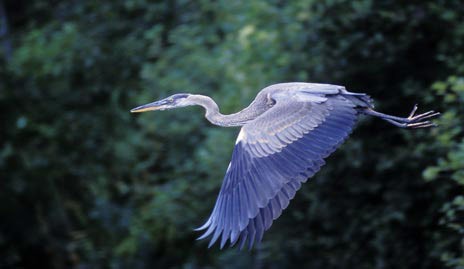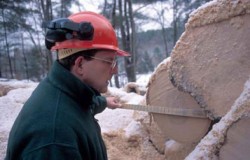Jon Raymond had some problems. About 100 of them, each one covered with blue feathers.
Those who know him might not have found this surprising. He is on the board of directors of the New York State Bluebird Society. He is also, however, a consulting forester by profession, and those blue feathers belonged to a nesting colony of great blue herons, right smack in the middle of a logging project he was hired to manage in Buskirk, New York, in Rensselaer County, east of Saratoga Springs.
On his initial walk-through of the job site, Raymond was impressed with the timber on the site. Good soils on this former pastureland that hadn’t seen cattle for much of the last century had produced beautiful stands of large-diameter black cherry, soft maple, and red oak. And then he discovered the heronry. It was in an excellent spot, from a heron’s perspective. The nests were located at the height of land, in the tallest of the aspen trees that were the major component of that part of the 38-acre woodlot. From the heronry, the birds overlooked a large, swampy backwater of the Hoosick River, which flowed less than a half-mile away. A nearby island and expanses of shallow-water shoreline provided a tremendous feeding area for the herons with a very short “commute.” He watched parent birds returning to the nest to feed fledglings at 10-minute intervals. From the neighbors he would learn that there had been herons nesting in that location for nearly four decades. Raymond, whose business card reads “Woodland Caretaker,” did not want to do anything to compromise that long history.
He was faced with a challenge.
The property was held by an estate, whose heirs had requested that the harvest produce maximum revenue. Raymond discussed the heronry with the estate’s executor and reached an agreement to make preserving the heronry a top priority, as long as doing so did not affect the financial outcome. This was all Raymond needed.
Much of the literature on the great blue heron mentions its sensitivity to human activity around the nesting site and treats it as a foregone conclusion that logging spells the end of a heronry. Therefore, at the Buskirk site, all harvest activities were done in the winter, when the birds were gone. This had the secondary benefit of enabling Raymond to easily see the nests and determine the boundaries of the nesting area. This done, he did some research to see what else the birds might need. The great blue heron is known by a number of common names – Big Cranky, blue crane, gray crane, Long John, Poor Joe, Treganza’s heron, and blue hero – and it also has an interesting scientific name, Ardea herodias. Ardea means heron in Latin, and herodias means heron in Greek. Therefore, the scientific name translates as “heron heron.”
The great blue heron is best recognized by its large size and stately demeanor. Adults average 38 to 54 inches in height, with 24 inches of that being their long legs. Great blues are especially distinctive in flight, with their necks folded back in an S-curve and their long legs trailing straight back. A wingspan in excess of 6 feet allows the birds to maintain a cruising speed of 20 to 25 miles per hour, and deeply dished wings allow the 6- pound birds to negotiate the slow takeoffs and landings necessary on very small bodies of water without damaging their delicate legs. On the ground, they walk with long, silent strides as they search the shallows of fresh, brackish, and salt waters for fish, amphibians, crustaceans, and larger insects. They have also been known to stalk through freshly mowed hayfields feasting on mice and voles.
The great blue heron’s nesting habits were the primary concern in Buskirk. Herons nest communally, preferring to place their large stick platforms in the tops of the highest trees in the area chosen for the heronry. Some trees will hold several nests, the highest belonging to the oldest pair and lower ones to their young that have reached breeding age themselves. Like the nests of eagles and ospreys, a heron nest is a work in progress, an edifice that is added to each year. Since a heron may live seven or eight years in the wild (the oldest in captivity reached 23) and juvenile females tend to nest in the same areas as they were born, some heronries can get quite large. While the average is 20 to 30 nests, heronries have been recorded with as few as a dozen to as many as 160 individual nests. The Buskirk heronry held 50 nests in a 2-acre area.
Nest-building herons may pick up some sticks from the ground, but they often break them off the very tree they are nesting in. A few years of this kills the tree, and ultimately, many heron nests topple when the wind breaks off the dead top of their tree. Losses from wind damage, heavy rain, predators, and lightning cause significant mortality, and roughly 69 percent of all young herons hatched do not make it to their first birthday. When the nest falls or becomes unstable, the parent birds move to the next-highest tree of the preferred species in the immediate area. Therefore, to sustain itself over time, a heronry site must have good recruitment and growth of the preferred tree species. Newly created wetland areas sometimes attract herons for a couple years, but as the trees die out, the birds are forced to move. A long-term heronry requires quite a number of elements, all in the proper balance.
With his research done, Raymond began marking trees for the harvest, which took place in December 2003.His plan included a walking trail and central woods road, both located so as to avoid traffic directly through the heronry. A 50-foot buffer zone was left all around the perimeter of the existing heronry, and no aspen were cut even beyond that buffer. His hope was to avoid windsnap, which has been a traditional problem in the area. Aspen was the key species to keep going, but it’s an early successional species with a relatively short life span, which can make it difficult to maintain in steady supply over time. Raymond was able to make half-acre patch cuts of the more valuable red oak and black cherry that were adjacent to large aspen. The aspen would have more room to grow bigger crowns and would provide a seed source to take over these half-acre seedbeds. The herons were not the only wildlife species considered in this process. Several large trunk sections were left on the ground at various points as drumming logs for grouse, and seed oaks were left to provide acorns for wildlife food and regeneration.
The harvest was done in the winter, and all operations were finished well in advance of the herons’ return in the spring. Raymond had been successful in maximizing the income for the owners. He removed nearly 100,000 board feet of oak and cherry, much of it veneer, and the heirs were very pleased with the revenue.
That part of the job was clearly a success, but what about the herons? Raymond knew he had done everything he could, but it was not without a good deal of anxiety that he returned to the Buskirk project to check on the birds. In order to not disturb the fledglings – if indeed there were any – he had to wait until July. He liked what he saw on the way in. The sunny openings were filled with green. A grouse drummed off on the eastern portion of the lot. A young whitetail buck, his antlers just showing the velvet promise of a fall rack, was jumped out of his bed along the walking trail. However, the forester could not relax until finally he heard what he was hoping for: that first hoarse croak of a heron leaving a nest.
The huge blue birds had returned.
Every nesting tree from the previous year was being used, and, even better, several new nests had been started. Not only was the heronry still viable, it was growing. As the summer months passed, and in spite of very high winds that toppled some nests and killed some nestlings, young herons continued to grow, and the heronry fledged as many as 30 youngsters to begin the migration south. The following July, Raymond saw that there was even further expansion of the rookery, with an additional eight new nests.
Raymond knew that all the heron literature depicts human intrusion, especially logging, as an anathema to a heronry. The Buskirk project can be seen as a test of that foregone conclusion. While it is early to call this an unqualified success, there is reason to hope, as the third spring following the harvest arrives, that what was good for the landowner, good for the logger, and good for the buyers of the timber, will be good for the great blue herons.
By paying attention to the attributes needed by the birds, and carefully planning and executing a harvest designed in part to regenerate the aspens that they prefer, Raymond hoped to ensure that the herons will have nesting trees far into the future. This summer, he’ll be back once again to see how well the birds are faring.







